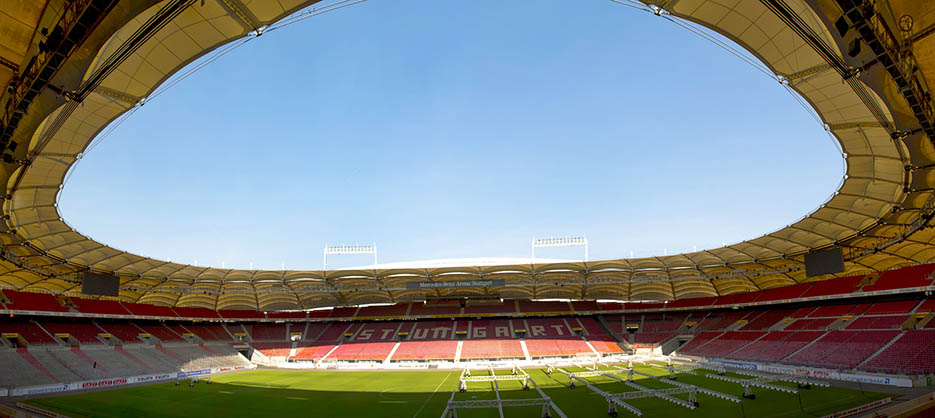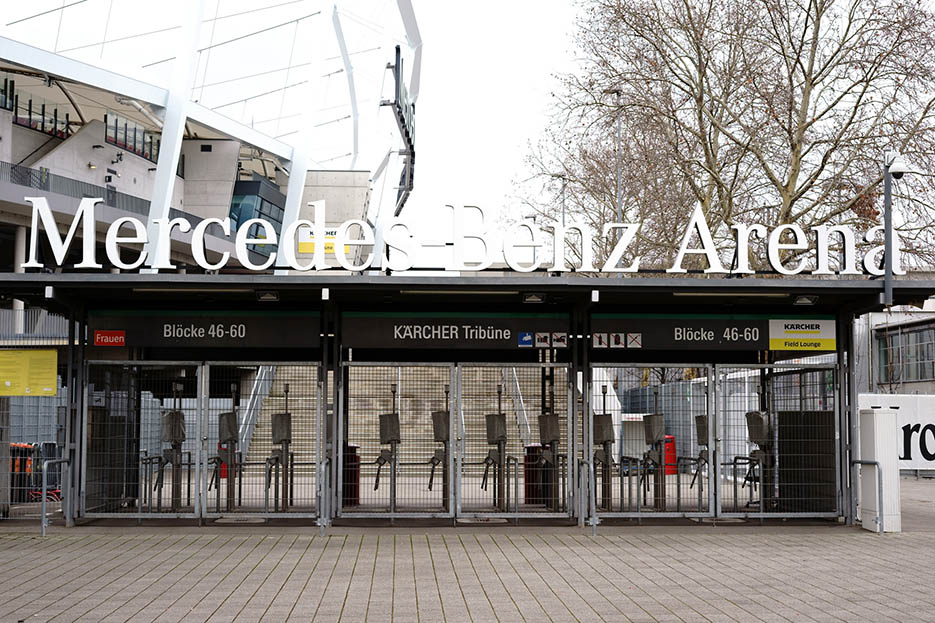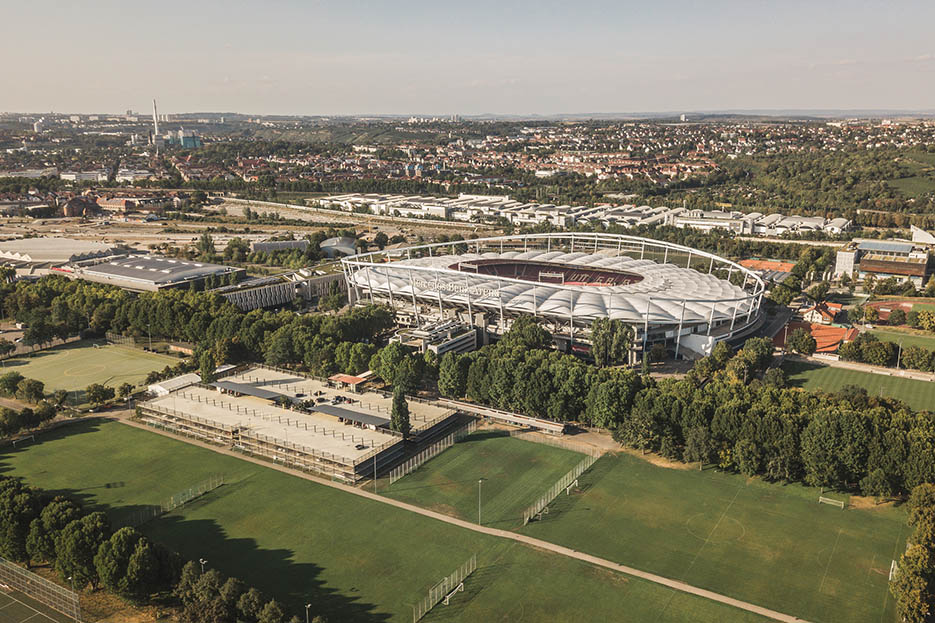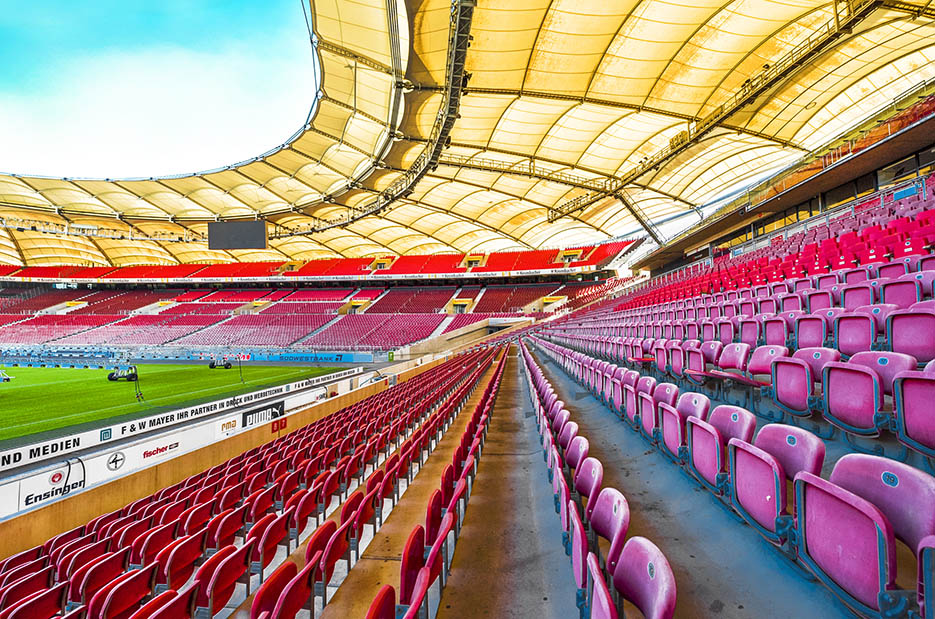Frankfurt Arena Complete Guide - Furnace Too Hot for the City
One of the Bundesliga’s most fiery stadiums will host the 2024 EURO matches - check out all you need to know in this Frankfurt Arena Complete Guide.

A perfect destination for those who besides football, also consider themselves petrolheads or, gearheads, or have any affinity towards motor vehicles. Yet Stuttgart is still a football city and the samely-named club has given the inhabitants plenty of reasons to be proud. One of them is the stadium itself. This Stuttgart Arena complete guide will reveal all the reasons as to why. But the main one is simple - it’s the joint home to the faithful Swabians. Known also as The Reds.
The Stuttgart Arena is the name the ground bears in international competitions as UEFA prohibits the use of sponsor names for their competitions. Such as the EURO 2024.
While it is the case with many modern stadiums, the Stuttgart Arena had an identity crisis as a result of the frequent name changes. Perhaps being the worst example of it.
- Between 1929 and 1933 it was called Stuttgarter Kampfbahn.
- From 1933 to 1945 the stadium was called Adolf-Hitler-Kampfbahn.
- Briefly, from 1945 to 1949 it was called Century Stadium.
- From 1949 until 1993 the arena was called Neckarstadion, after the river that passes nearby.
- Between 1993 and 2008 Stuttgart Arena was called the Gottlieb-Daimler-Stadion.
- From 2008 to 2023 the stadium beared the very fitting name Mercedes-Benz Arena.
- Since 2003 the usual stadium’s name is the MHPArena.

The city of Dortmund will host six EURO 2024 matches with four in the groups and one in the knockout stages.
Hungarian fans will be the most present as they have two games at the Stuttgart Arena in a span of four days. Considering Stuttgart is in the southern part of Germany, Hungary is just 555 kilometres away.
- Slovenia vs Denmark (Sunday, June 16th, 18:00) in Group C
- Germany vs Hungary (Wednesday, June 19th, 18:00) in Group A
- Scotland vs Hungary (Sunday, June 23rd, 21:00) in Group A
- Ukraine vs Belgium (Wednesday, June 26th, 18:00) in Group E
- Quarter-final (Friday, 5th of July, 18:00)
Stuttgart is located in the southwest of Germany, within the Baden-Wurttemberg federal state.
It's 71 km away from the nearest border with France to the west, 112 km away from Switzerland in the south, 164 km away from Austria to the southeast and 264 km from the Czech Republic in the east.
The nearest other major German cities are Munich - 190 km away to the southeast, Frankfurt 150 km north, and Nuremberg 160 km to the northeast.
Stuttgart has a population of 635,911 people and is the sixth-largest city in Germany. But it's a densely populated area as 2.8 million people live in the city's administrative region] and around 5.5 million people in its metropolitan area.
Stuttgart is an economic powerhouse and its metro area is listed amongst the top 10 in the size of GDP amongst EU countries. Several major corporations have their headquarters in Stuttgart, including Porsche, Bosch, and Mercedes-Benz Group.
Stuttgart lies on the river Neckar, and while now it's known for the tech companies, it used to be primarily known as an important agricultural area.
But the name and the coat of arms stem from the Old High German word Stuotgarten, which means "stud farm" - because the city was founded in 950 AD by Duke Liudolf of Swabia to breed warhorses.
You’ll recognize the coat of arms from the Porsche’s crest certainly.

MHPArena Home to VfB Stuttgart, a club known for producing amazing players in their academy - likes of Joshua Kimmich (one of the best current German players), Mario Gomez, Timo Werner, Bern Leno, Serge Gnabry, and Sami Khedira all came up through their youth ranks.
Originally, the stadium was built in 1929, but it was renovated between 1949 and 1951, then 1999 and 2003, and then in 2004 and 2005 for the 2006 World Cup.
Yet the ground also experienced renovation for the Euro 2024, starting in 2022 and ending in January of 2024. Mostly focusing on the lower level of the main terrace and the amenities.
For the expansions that happened in 2001, 2004/2005, 2009-2011, and 2017 the price was a cumulative €135,700,000.
While the latest renovation had a cost of €130,000,000!
Stuttgart Arena was one of the host cities for the 1974 World Cup in West Germany. With four group matches happening here, Poland involved in three of them, Argentina and Italy with two. A crowd of 70,1000 watched the two games of the Azzurri.
The Stuttgart Arena was also utilized for the EURO 1988 with two matches played here, one in the groups, and the other a final in which the Soviet Union defeated Italy.
In 2006, Stuttgart Arena hosted six matches of the World Cup! Four group games, one in the round of 16, and then the third-place match in which the hosts Germany took the consolation prize.
On the club level, Stuttgart Arena was utilized on the biggest stage in 1959 when Real Madrid won the European Cup (Champions League) against Reims.
While 1988 was also a busy year, as besides the two EURO games, PSV Eindhoven and Benfica played the European Cup final here, with the Dutch side winning on penalties.
1950, the first German international match post-World War II was played here against Switzerland in front of 103,000 spectators!
The German national football team frequents here occasionally today and the last game in Swabia was a 6:0 dismantling of Armenia in the qualifications for the Qatar World Cup.
The architects of the original stadium were Paul Bonatz and Friedrich Eugen Scholer while the company 'asp' Architects Stuttgart were in charge of the last renovation as well as the one finished in 2011.
In that 2011 concluded renovation, the Stuttgart Arena was turned into a pure football ground, with the track and field tracks removed.
The current capacity of the Stuttgart Arena is 60,058 spectators, 50,998 of which are seated. While 2,528 of those spots are classified as business seats.
With 66 boxes that can hold up to 956 people
But in UEFA games, like the EURO 2024, the capacity is 51,000.
The whole Stuttgart Arena is 273 metres long and 224 metres wide.
The highest point of the stadium is 47 metres tall.
The actual playing area of the pitch has the dimensions of 105m × 68m.
There are two LED video screens with a size of 61.2m? each.

The Stuttgart Arena is located four kilometres northeast of the city centre. Where both the main train and the main bus station are located. However, they are the lowest-rated stations amongst the ones we covered in this breakdown of the Euros 2024 stadium. Which includes Gelsenkirchen, Leipzig, and Dortmund amongst others.
Daily long-distance domestic routes to Stuttgart Central Station include:
Hamburg – Belin – Leipzig – Stuttgart – Munich
Hamburg – Frankfurt – Stuttgart
Dortmund – Cologne – Frankfurt Airport – Stuttgart – Munich
International train destinations include Paris, Strasbourg (France), Innsbruck, Vienna, Salzburg (Austria), Budapest (Hungary), and Zurich (Switzerland).
The Stuttgart International Airport is 9.5 km from the city centre in the south, and 11.2 km from the MHPArena. It’s located on the edge of the A8 highway that encompasses the city from the south.
Stuttgart has a light-rail "S-Bahn" that transverses beneath the ground in the urban areas becoming a U-bahn or subway.
S-Bahn (S1) train stops at the NeckarPark station on matchdays, but Bad Cannstatt station – which can be reached on the S2 and S3 trains – is just a 15-minute walk away from the arena.
The U-Bahn lines U11 and U19 have a stop at the Stuttgart Arena too, named NeckerPark (Stadion). With U11 starting in the city centre.
Bus lines 45 and N5 travel towards the Stuttgart Arena as well.
Stuttgart will have several fanzones for the EURO 2024.
Schlossplatz, a beautiful green square located in the city centre will host the public viewings, along with free sporting and sponsor activities.
Schillerplatz, adjacent to Schlossplatz will house a range of regional food and beverage outlets.
Karlsplatz, also located nearby will have a performance programme which includes live music, dance, lectures, and more.
Marktplatz, a bit more to the south will host family activities.
So Stuttgart will actually have a single but clearly divided and designated large fan zone.

In the city centre, Altes Schloss can't and shouldn't be missed. Originally built in the 10th century, is now partially a museum of history.
Neues Schloss is also located rather centrally and is in the middle of the fanzone as well. Schloss Solitude or Palace Solitude built in the 18th century is 6.8 kilometres away from the city centre and is truly stunning.
Stuttgart's main landmark is the TV Tower with a viewing platform of two levels at a height of 150 metres.
Stuttgart is probably the most well-known for being the home of Porsche and Mercedes. Both massive companies have their highly-rated museums.
Porsche Museum is a bit out of town, located 6 km north of the city centre.
Mercedes-Benz Museum is however just 265 metres away from the MHPArena!
This is why it's surprising that Mercedes-Benz let their lease on the stadium's naming go to MHP, which proudly states that it is "a Porsche company."
But Stuttgart has love for other forms of transportation with the Straßenbahnmuseum Stuttgart or the World of Trams Stuttgart also close to the arena, just one km away.
If oddities, not automotive is more your lane, you'll be glad to find out about the SchweineMuseum Stuttgart. Yes, a pig museum. Located in an old slaughterhouse near the left bank of Neckar, it is focused on the history, mythology & gastronomy of pigs.
Wilhelma Zoo and Botanic Garden is located in a big park called Rosensteinpark. Which also contains the State Museum of Natural History.
Stuttgart is also located 28 km from Germany's Black Forest and 52 km from the Swabian Jura, or the Swabian Alps mountain range for nature lovers.
Staatsgalerie Stuttgart is a popular modern art museum.
Grabkapelle is a Mausoleum monument of eternal love built in 1820 for the deceased wife of King Wilhelm I. It overlooks the city while providing a magnificent view of it.
There are other sights like the planetarium and many different museums and castles and palaces.
Besides the automotive industry, football, and historic importance, Stuttgart is known as a big wine region as well.
Not even adjusting for the size of the city, Stuttgart seems like the best tourist option out of all the German cities we covered on this list. Offering plenty of diverse options.
So seemingly the Slovenians, Danes, Hungarians, Ukrainians, and Belgians who are certain to play matches here - besides the home team - have hit the draw jackpot.
Hostels range from €45 per night, apartments around €90 per night, and hotels go from €160 per night but the rates will certainly increase by the time.
Stuttgart-Mitte is the central neighbourhood of the city with Bad Cannstatt - encompassing the Stuttgart Arena - being the other important one.
Considering that the Leonhardsviertel area known for bars, clubs, and lounges is located in Stuttgart-Mitte, pick your staying spots accordingly.
Stuttgart Arena's complete guide has been a revelation of Germany’s semi-hidden gem. There is not something, but a lot for everyone in Swabia.

One of the Bundesliga’s most fiery stadiums will host the 2024 EURO matches - check out all you need to know in this Frankfurt Arena Complete Guide.
Arena AufSchalke complete guide will inform you about all you need to know in order to have a fulfilling EURO 2024 experience in Gelsenkirchen.
The Leipzig Stadium guide will get you up to speed with everything you need to know for the Euros 2024. But also for visiting the Red Bull Arena otherwise.
BVB Stadion Dortmund complete guide will have you geared up and completely ready for the ultimate EURO 2024 experience in one of Germany's best football cities.
Discover everything you need to know about the Munich Football Arena, in order to have the best experience at the Euro 2024 or anytime visiting the Bavarian cap